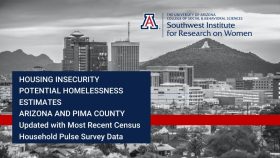
The University of Arizona Southwest Institute for Research on Women has released its most recent update to its report on Housing Insecurity Indicators and Potential Homelessness Estimates for Arizona and Pima County. This report measures current housing insecurity with newer census data.
This most recent survey wave contains multiple pieces of concerning news.
- In the previous survey wave, collected September 20th-October 2nd 2023, the proportion of non-current renters in Arizona was 11.5%. In the most recent survey, conducted October 18th-30th 2023, this proportion fell modestly to 9.4%. While the proportion not current on rent payments decreased, the proportion of these non-current renters viewing eviction in the next two months as “very likely” increased to 19.9% (up from only 5% last survey wave).
- In October of 2023 we observed the largest monthly count of eviction filings in Pima County since the onset of the pandemic with 1307 eviction filings. Eviction filings continue to increase despite the strong economy and the relative slowing of rent price increases over the past year
- Housing insecurity among Arizona renters remains stubbornly high despite historically low unemployment. Rising rents and inflation are likely the central drivers of this disconnect, especially for households with limitations on their ability to benefit from the strong labor market.
- Lower-income and BIPOC Arizona households remain disproportionately likely to report being not current on their rent payments and finding it very difficult to meet usual expenses. 39% of Black Arizonan heads of households reported finding it very difficult to meet usual expenses in the past week in this most recent survey. This situation was also reported by 25% of Hispanic or Latino heads of household in Arizona, and over 40% of households earning less than $25k a year (surveyed this wave).
There is continuing good news to report on rents.
- The positive macroeconomic situation has continued to hold steadily at both the national and state levels. The unemployment rate in Arizona, 4.0% in September, is a modest increase relative to a low of 3.4% this past May but remains well below historical averages.
- Mortgage holders in Arizona continue to be in a strong financial position relative to renters. Only 6.3% reported being not current on mortgage payments (up modestly from a low of 3.5% in August of this year). However, among these non-current mortgage holders concern about the likelihood of foreclosure in the next two months is at the lowest levels observed in these surveys to date. Further good news is that since, roughly, February of 2023, counts of calls to 211 from Pima County indicate a substantial decrease in calls related to housing and shelter, utilities, and food requests between February and July.
- In the fall of 2022 Tucson rent prices began decreasing on average, albeit very modestly. In the Spring of 2023 of rent prices in Tucson registered modest upticks in median/average rent prices. Despite these increases, seasonally adjusted metrics of Tucson rent prices increased only 3.3% between September 2022 and September 2023. This is a substantial slowdown in the rate of rental price increases we have seen in recent years. In addition, there is unambiguous good news in the rental vacancy rate, which has been trending upwards since the end of 2021, and hit an 8-year high in the 2nd quarter of 2023. On the other hand, only 47% of all Arizona respondents reported they had not experienced pressure to move in the last 6 months. 10% of Arizona households reported reducing or not paying expenses for basic household necessities (such as medicine or food) “almost every month” in the last 12 months in order to pay an energy bill. Only 50% of households reported “never” being in this situation.
